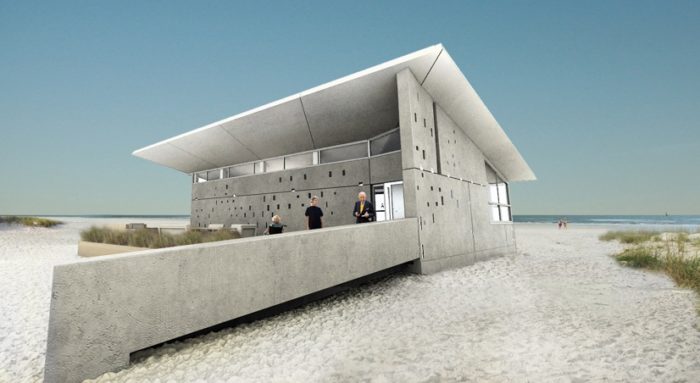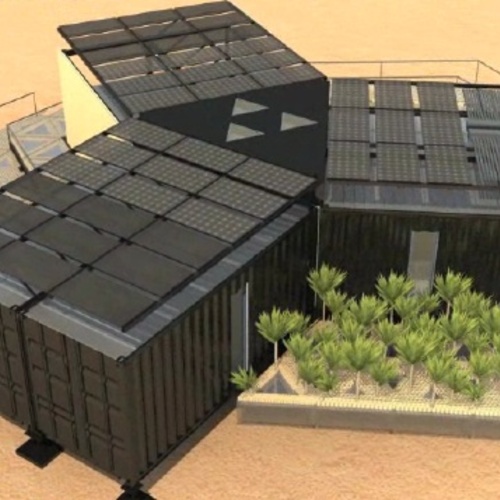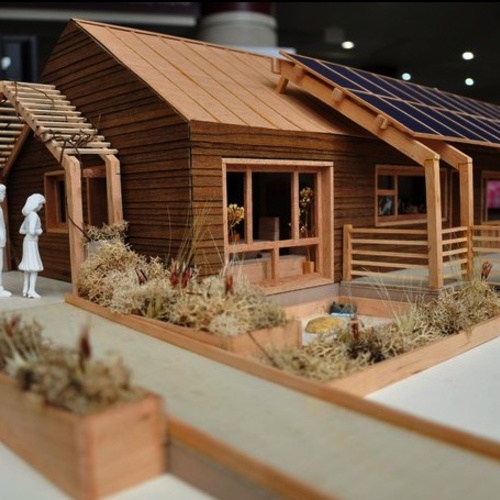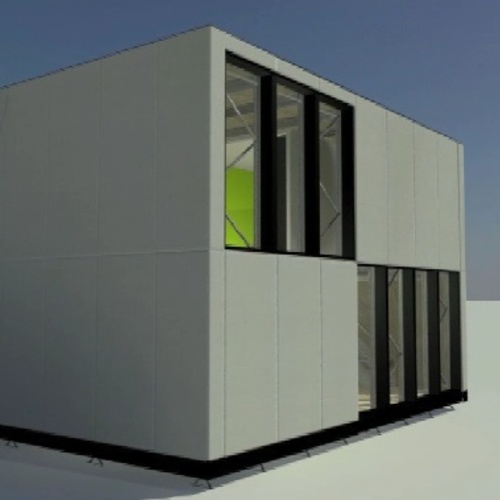
Image Credit: Rutgers: the State University of New Jersey and the New Jersey Institute of Technology
Image Credit: Rutgers: the State University of New Jersey and the New Jersey Institute of Technology Sunlight reaches the eNJoy interior through punched openings in the concrete panels, clerestory windows on the north and west walls, and large windows on the south wall (visible here in the dining and common areas). The target buyers for eNJoy are couples who want to live on or near New Jersey’s Atlantic coast. Mechanical components will occupy a portion of the building’s central core. Precast concrete panels comprise most of the shell, including the roof. The view from the main entry of the house. The north and west walls of the house are topped with clerestory windows. The exterior walls off the kitchen, dining, and common areas feature a lot of window space. The deck near the main entrance, on the north side of the house.
The target market for Team New Jersey’s entry in the 2011 Solar Decathlon is a couple (perhaps retired) who wants a small, durable, energy-efficient house suitable for the Jersey shore. And in practical terms, trying to appeal to home buyers longing for respite somewhere along New Jersey’s long, lively, and mostly pleasant Atlantic coastline probably isn’t a bad idea, provided you’re willing to put up with allusions to MTV’s “Jersey Shore.” It’s unlikely the members of Team New Jersey – a collaboration of students and faculty from Rutgers: the State University of New Jersey and the New Jersey Institute of Technology – weren’t expecting joking references to the show (are there any other kind?) and other digs at Jersey Shore pop culture. But they’ve become experts at deflecting snark by steering attention to the amenities of the home, dubbed “eNJoy: A Generation House.” The 960-sq.-ft. one-bedroom house has a shell of precast concrete panels and an inverted hip roof that, with its large overhang, is designed to maximize rainwater collection.
Live at the International Builder’s Show
As architecture student Zachary Hvizdak told Fine Homebuilding’s Justin Fink during an interview at the International Builders’ Show in Janaury, the team aimed for a blend of contemporary design and energy efficiency performance that will make the most of the insulation, durability, and thermal mass of concrete. “We’re pushing this technology,” Hvizdak said, noting that because all of the panels are being custom made, eNJoy’s construction costs will exceed $250,000, which means the project likely won’t be competitive in the Decathlon’s affordability contest. Born to run – on the sun In addition to the thermal mass value and durability of precast concrete panels, the team cites a few other advantages to their use, including their resistance to mold, their adaptability to sturdy modular construction, their low maintenance, and the recyclability of concrete. Made by Northeast Precast, based in Millville, in southern New Jersey, the panels feature about 6 in. of rigid foam insulation sandwiched between 3 to 4 in. of poured concrete.
MORE INFORMATION Team New Jersey Web page DOE Web page for Team New Jersey GBA Resource Guide for 2011 Solar Decathlon
Despite all the concrete, eNJoy aims for a stylized contemporary look – a solid form with small punched openings to let in light, although most of the daylighting comes from a long line of clerestory windows on the north side of the house and a contiguous stretch of large windows on the south side. Hvizdak points out that the large inverted hip roof gives homeowners significant flexibility when placing the building’s photovoltaic panels and solar hot water collectors for optimal exposure. As on a flat roof, the PV and solar hot water panels on eNJoy, when installed on angled mounts, can be grouped on the north or south portions of the roof, depending on surrounding foliage, to maximize exposure to the sun. The building’s electrical system, HVAC appliances, and plumbing will be concentrated in a central core – in one of three modules that will be bolted together to form the main structure. From NJ to DC and back Once it has prepared them for shipping, the team will load the three modules, along with the PV array, entry ramps, decking, and landscaping components, onto a total of seven trucks. The team expects to take about two days to reassemble the house on the National Mall in Washington, D.C. Upon its return to New Jersey, the house will be offered for sale. Construction costs are expected to be about $300,000, although Clinton Andrews, a professor at Rutgers and one of the project’s faculty leaders, told the CourierPostOnline, which covers southern New Jersey, that about $100,000 could be trimmed from those costs if the house were to go into production. We’ve asked the team for more details about the materials and mechanicals used, and the expected performance of the building. Whether the eventual buyer of the prototype is in fact a couple interested in a spot near the Atlantic shore remains to be seen, although the team certainly would entertain an offer from MTV. “If they were the ones to buy the house,” Hvizdak told Fine Homebuilding, “it would be OK.”
Weekly Newsletter
Get building science and energy efficiency advice, plus special offers, in your inbox.















3 Comments
Thermal Envelope??
I was wondering what the insulation levels were??
First and foremost, one
First and foremost, one should never make generalizations based on ethnicity. The term "guido culture" is highly discriminating and offensive to many. It was probably an innocent mistake but discriminatory none the less. Secondly as much as I can appreciate the effort and creative design of the students and this project, I am astonished at the cost. In my opinion, and that is all that it is, a 960 square foot house that cost 250,000 to build does not satisfy the need for affordable energy efficient structure, and does nothing more than offer the benefits of high performance homes to the wealthy. The elderly couple that purchases this home better be living on more than a fixed income to afford it. Unless the cost of the site is included in that package, this seems to be way off the charts for square footage building costs for this type of home. Renewable technologies have always been affordable to the wealthy, but not the masses. It is the masses that need Innovative, cost effective design and renewable technologies in order to combat our wasteful energy policies and practices and, and to ultimately reduce the effects of climate change. That aspect gets ignored by designing "High Performance Homes for the Rich and Famous". Is the Solar Decathlon about showcasing "High Performance Affordable Housing" meant for all, or only a few. If the latter is the answer than those in charge of the program need to rethink the priorities.
Response to Edward Palma
Edward,
I agree completely with your point about ethnic generalizations; thanks for your comment. I have removed the phrase from the article.
Log in or create an account to post a comment.
Sign up Log in